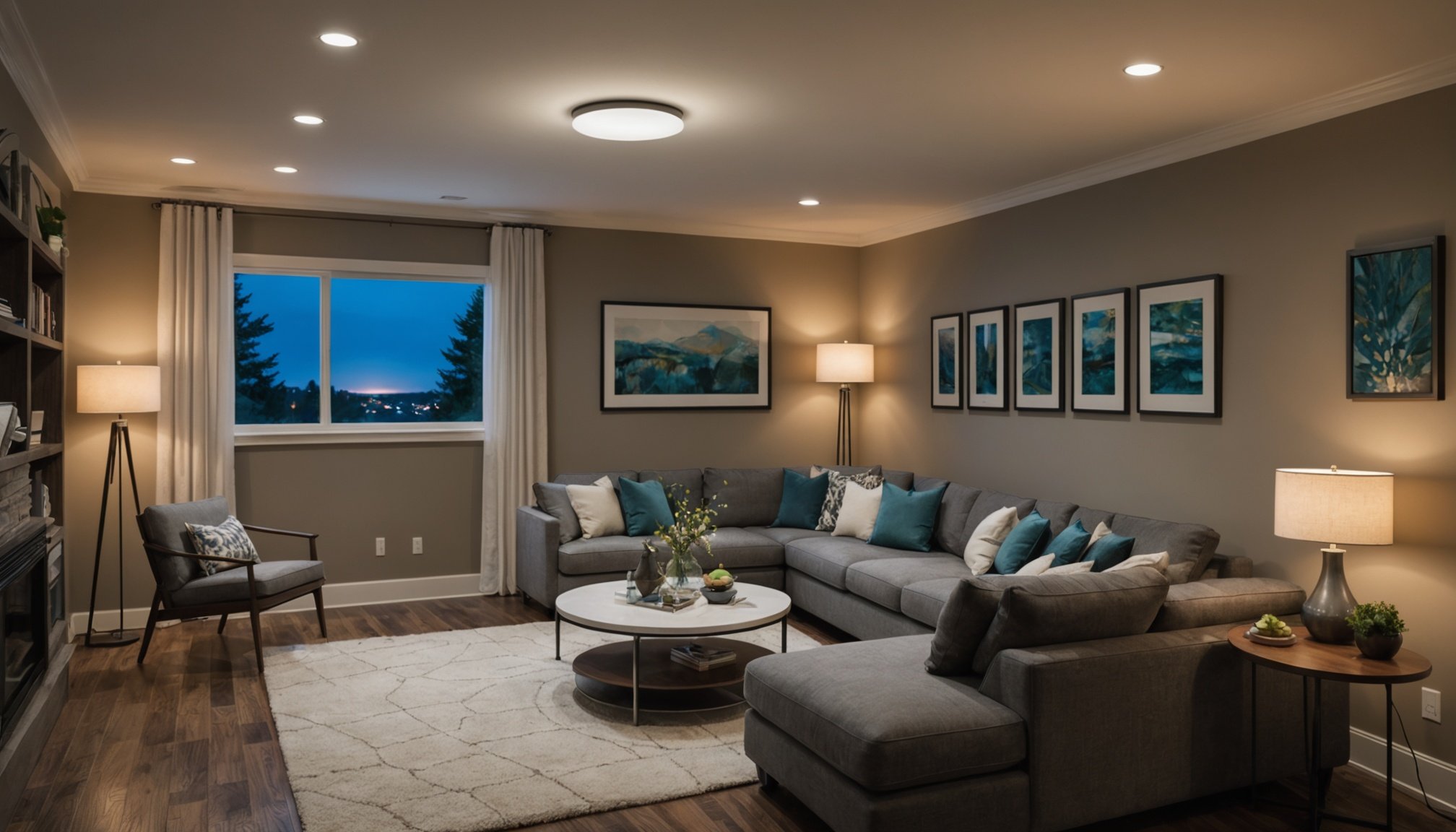Overview of Smart Lighting Solutions
Smart Lighting systems are a gamechanger in the realm of home automation, transforming how we interact with our living spaces. Smart lighting allows homeowners to control brightness, colours, and schedules of their lights remotely, often through an app or voice commands. This innovative lighting technology enhances convenience and energy efficiency, making it a cornerstone of modern smart homes.
Integrating smart lighting systems offers myriad benefits. For instance, homeowners enjoy energy savings by using automated schedules or motion sensors to ensure lights are only on when needed. Additionally, customisable settings improve ambience, creating the perfect environment for any occasion with the touch of a button. Enhanced security features, such as automated lighting patterns, can deter intruders, giving peace of mind to users.
Also read : Designing a Chic Multi-Tiered Indoor Plant Stand Perfect for Minimalist Interiors
The latest advancements in smart lighting technology have increased the systems’ capabilities and accessibility. Innovations include adaptive lighting that mimics natural light cycles, promoting healthier circadian rhythms, and improved compatibility with a broader range of smart home devices. Other noteworthy advancements are wireless and battery-operated options, which offer easy installation in any home, eliminating wiring constraints.
In essence, smart lighting solutions are not merely about illumination; they are about seamless integration, personalisation, and contributing to a greener, more connected world.
Also to discover : Creating an Eco-Friendly Gym: Innovative Energy-Generating Workout Equipment for Sustainable Fitness
Comparison of Smart Lighting Products
Smart lighting has become an essential element in modern homes, offering convenience and energy efficiency. When considering smart bulbs and smart lights, it’s important to examine the offerings from popular brands, as well as key features and performance versus price.
Popular Smart Lighting Brands
Several brands stand out in the smart lighting market, each offering a unique range of smart bulbs and smart lights. Philips Hue, LIFX, and Wyze are leading contenders, providing a variety of options that cater to different preferences and budgets. Philips Hue, known for extensive compatibility and robust ecosystem, offers a wide selection of bulbs and fixtures, while LIFX is praised for vibrant colors without needing a hub. Wyze, on the other hand, appeals to budget-conscious consumers with its affordable smart lighting solutions.
Key Product Features
When comparing smart lights, features such as color range, connectivity options, and ecosystem integration can make a significant difference. Look for products offering:
- A broad range of colours
- Compatibility with smart home systems like Amazon Alexa and Google Assistant
- User-friendly apps for easy control
Pricing and Performance Analysis
Cost versus performance is a crucial consideration when choosing smart lighting. Philips Hue may be on the higher end, but their performance and reliability often justify the investment. LIFX offers mid-range prices with impressive brightness and vibrant color options. Wyze provides a balance between cost and simplicity, making it ideal for those new to smart bulbs.
Integration with Home Automation Systems
Home automation integration allows various IoT devices to work seamlessly together, enhancing your living experience. Popular smart home compatibility platforms include Google Home, Amazon Alexa, and Apple HomeKit. These platforms support a range of devices, providing a cohesive ecosystem for smart living.
Smart Lighting Integration
Integrating smart lighting with home automation systems typically involves connecting the lighting system to a compatible platform. Start by verifying the smart lights’ compatibility with your chosen home automation controller. Follow the setup instructions provided by the smart light manufacturer, which usually require downloading an app and connecting the lights to your home’s Wi-Fi network. Once connected, use the home automation app to add and manage the devices.
Ensuring Interoperability
To ensure your smart devices work together, consider these factors:
- Compatibility: Check that all devices support the same platform.
- Connectivity: Reliable Wi-Fi is crucial; ensure signal strength covers all areas.
- Updates: Keep device firmware and apps updated for better performance and security.
By focusing on these considerations, you can create a more integrated and functional smart home environment. Being technologically savvy can significantly enhance the benefits of smart home devices, from energy efficiency to user convenience.
Installation and Setup Guide
Installing a smart lighting system can enhance your home’s ambiance and energy efficiency. Delving into the setup, ensuring you are well-prepared with the right information is crucial for a smooth process.
Tools Required for Installation
Before diving into the installation, gather these essential tools:
- Screwdriver Set: A basic tool that helps in removing existing light fixtures and installing new ones.
- Voltage Tester: Ensures safety by confirming power is off before starting.
- Wire Strippers: Essential for handling and connecting wires safely.
- Ladder: Necessary for reaching ceiling fixtures comfortably.
- Drill (optional): For drilling holes if needed depending on the fixture type.
Step-by-Step Installation Process
- Turn off Power: Begin by switching off power at the circuit breaker.
- Remove Old Fixtures: Using a screwdriver, carefully remove existing fixtures.
- Connect the Wires: Strip wires as needed and connect to the smart light according to the Setup Guide.
- Secure the Fixture: Use screws to install the smart light fixture securely.
- Turn Power On: Switch the power back on and follow the manufacturer’s app or DIY Tips to complete the setup.
Troubleshooting Common Issues
Encountering problems? Common issues include connection errors or unresponsive lights. Start by:
- Checking that your Wi-Fi is functioning properly.
- Ensuring all wires are secure.
- Rebooting your equipment may resolve unexpected connectivity issues.
If problems persist, consult the Smart Lighting Installation manual or seek professional assistance.
Optimizing Smart Lighting for Your Home
Lighting optimization is crucial for enhancing both energy efficiency and the overall ambiance in your home. Customizing your lighting scenes to suit various activities can greatly improve your living experience. For example, a reading scene might use a warmer hue, while a work environment might benefit from cooler, brighter lighting. Adjusting the intensity and color temperature depending on the activity can lead to optimized comfort and efficiency.
Implementing smart lights is a step towards significantly reducing energy consumption. These systems allow you to automate schedules and control lights remotely, ensuring lights are only on when needed. By utilizing motion sensors, you can effortlessly enhance energy efficiency by having lights switch off automatically when a room is unoccupied.
Another important factor is using smart lighting to boost your home’s aesthetic and ambiance. Through app interfaces, you can experiment with various hues and intensities to find the perfect atmospheric setting for entertaining guests or relaxing after a long day. The ability to sync lights with music or mood scenes adds yet another layer to personal customization. These small adjustments in lighting can transform the look and feel of your entire home, creating a welcoming and functional environment.
User Reviews and Experiences
Understanding user feedback on smart lighting involves not just seeing numbers, but feeling the heartbeat of everyday experiences. Unpacking user reviews provides valuable insights into what these devices offer—or don’t.
Gathering User Insights
To gain authentic user insights, manufacturers often rely on surveys and customer support records, tapping into real-world feedback. These methods highlight users’ appreciation for seamless integration and frustration over connectivity issues. They capture the full spectrum of user experiences.
Analyzing Common Feedback
Customer experiences frequently highlight a few key themes: convenience, improved ambiance, and cost savings as major positives. However, lighting feedback often notes that setup complexity can be a hurdle. Users value quick, intuitive experiences with smart systems but sometimes encounter steep learning curves.
Case Studies of Successful Implementations
Several homes have successfully adopted smart lighting to enhance day-to-day life. For instance, those integrating systems with voice assistants report significant lifestyle improvements. Families express joy in controlling their lighting effortlessly, creating a more hospitable environment. These transformations exemplify the positive impact user reviews underscore, marking a satisfying shift toward modern convenience.
Future Trends in Smart Lighting
Emerging technologies in smart lighting solutions are changing the way we think about illumination in our homes. Among these, IoT-enabled devices allow for seamless integration with home automation systems, offering enhanced control and convenience. Future technology is also expected to focus on personalisation, with lights that adjust to human habits and preferences. Imagine a system where your lights automatically dim or brighten based on the time of day, or even your mood.
Forecasts predict that smart lighting trends will continue to evolve with the progression of artificial intelligence. This will enable lighting systems to anticipate a user’s needs based on patterns of behaviour, creating a truly automated and thoughtful home environment. Additionally, future smart lighting is likely to emphasise energy efficiency, as sustainability becomes an increasingly crucial factor in innovation in lighting.
Significant innovations are on the horizon, such as lighting solutions powered by renewable energy and materials designed for longevity and environmental friendliness. As these advancements unfold, the role of smart lighting in home automation will become more prominent, providing not just energy-saving benefits but also improving quality of life by creating adaptive lighting environments that cater to individual needs.











